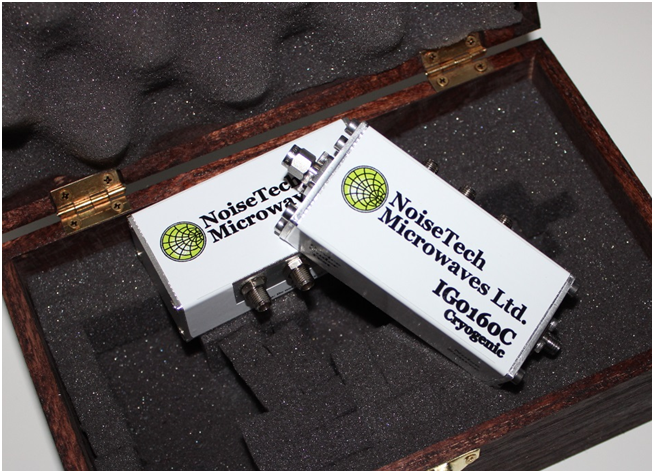Noise parameters give a complete view of the noise performance of two-port linear devices. For example, noise parameters are necessary for designing low noise amplifiers (LNA) so they achieve the lowest possible noise figure. For LNAs designed to operate at temperatures other than room temperature, the noise parameters should be measured at the intended operating temperature.
Cryogenic LNAs
Cryogenic LNAs (Cryo-LNA) are key receiver components in ultra-sensitive systems, such as radio telescopes, satellites and quantum computing. These LNAs can achieve exceptionally low noise temperatures, on the order of just 1 or 2 K. With noise temperatures this low, measurement of Cryo-LNA noise performance is difficult and subject to systematic errors from noise source uncertainties, in the range of 7 to 20 K or 0.1 to 0.3 dB uncertainty in noise source excess noise ratio.
To overcome this problem, the cold attenuator method is commonly used. With this method, an attenuator is placed in the cryogenic dewar at the input to the LNA. The attenuator loss reduces the amount of noise source uncertainty and improves Cryo-LNA noise figure measurement accuracy.
The recent trend is to equip radio telescopes with phased array feeds to achieve a wider field of view by creating multiple simultaneous beams and improving the telescope’s field of view and survey speed. An example of such a system is the Green Bank Telescope cryogenic phased array feed. Developments of phased array feeds, however, create a new Cryo-LNA characterization problem. For proper noise matching of the Cryo-LNAs to the phased array feed elements, the Cryo-LNAs are designed so their optimum noise matching equals the active reflection coefficient of the antenna array. The theory on determining the array active reflection coefficient is well developed; however, the measurement of Cryo-LNA noise parameters is not.
Fortunately, NoiseTech has expanded its line of solid-state impedance generators with cryogenic capabilities. The new cryogenic impedance generator is shown in Figure 1.

NoiseTech’s impedance generators are conceptually similar to mechanical source impedance tuners, yet are significantly more compact and repeatable. The RF part of the new impedance generators requires only three low frequency communication lines, for low thermal load on the temperature chambers, and is able to operate at a wide range of temperatures. The compact size and simple communication permit the placement of the impedance generators inside the temperature chambers and cryogenic dewars, allowing users to measure device noise parameters over various temperatures.
Noise Parameter Measurements with Impedance Generators
Noise parameters are extracted from noise figure measurements with at least four signal source impedances. NoiseTech’s impedance generators are designed to generate these signal source impedances at the device under test input, resulting in a diagonally dominant system of linearly independent equations at every supported frequency. Because the solution of such a system is guaranteed, there is no need to generate additional impedances.
A cold noise parameter measurement approach is used with NoiseTech’s impedance generators. Apart from the impedance generator replacing an impedance tuner, the other parts of the conventional noise parameter measurement system remains unchanged. The impedance generators are also capable of controlling noise sources, eliminating the need for specialized equipment for such functionality, such as noise figure analyzers. This allows the use of any spectrum analyzer or power meter.
NoiseTech impedance generators are supplied with fully customizable software, providing users with unlimited possibilities to set up tests and collect data most suited to their needs.
Typical Impedance Generator Specifications
NoiseTech's impedance generators are designed to operate from 0.1 to 6 GHz, covering most wireless standards, i.e., Wi-Fi, 3G, LTE, WiMax, Bluetooth, GNSS. Only four impedance states are required to cover the full frequency range while simultaneously guaranteeing diagonal dominance of the resulting system of equations at each frequency.
The average repeatability in the operating temperature range from 15 K to 345 K is around 85 dB over the full frequency range, with the worst-case repeatability better than 70 dB.
The room temperature part of the impedance generator is controlled via a host computer with a USB protocol.
Conclusion
NoiseTech Microwave’s new compact wideband impedance generators are unique, specifically designed for noise parameter measurements. As such, they are compact and operate over a wide range of frequencies and temperatures. NoiseTech has validated the operation of the impedance generators between 15 K and 345 K without any significant degradation in repeatability or the generated impedance constellation. The repeatability achieved is critical for noise parameter measurement.
The operation of NoiseTech impedance generators over a wide range of frequencies opens new opportunities for characterizing noise performance for cryogenic circuits, as well as during manufacturing testing of devices over temperature variations.
Additional information may be obtained at NoiseTechMicrowaves.com.
NoiseTech Microwaves Ltd.
Calgary, Alberta, Canada
support@NoiseTechMicrowaves.com
